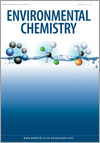EN13017A perspective on time: loss frequencies, time scales and lifetimes
Environmental context. The need to describe the Earth’s system or any of its components with a quantity that has units of time is ubiquitous. These quantities are used as metrics of the system to describe the response to a perturbation, the cumulative effect of an action or just the budget in terms of sources and sinks. Given a complex, non-linear system, there are many different ways to derive such quantities, and careful definitions are needed to avoid mistaken approximations while providing useful parameters describing the system.
EN13017 Abstract | EN13017 Full Text | EN13017PDF (26 KB) Open Access Article




